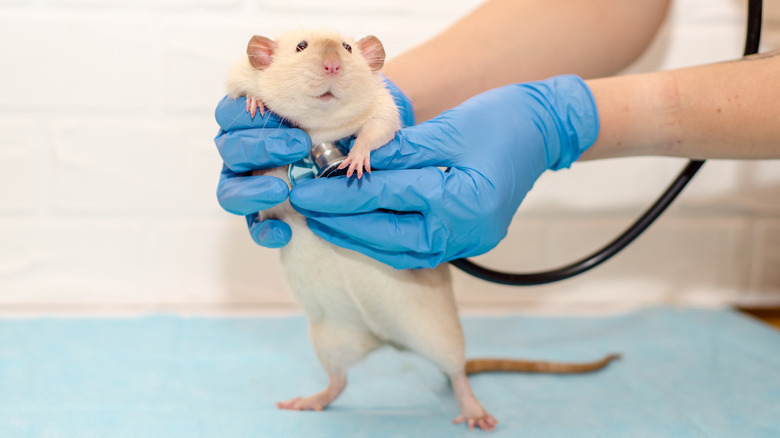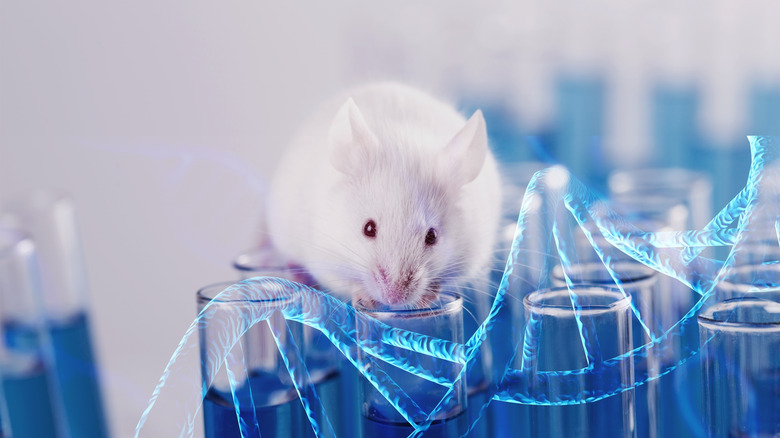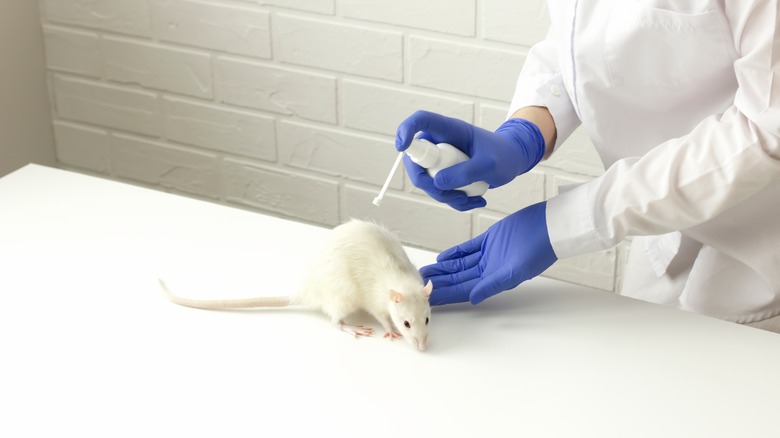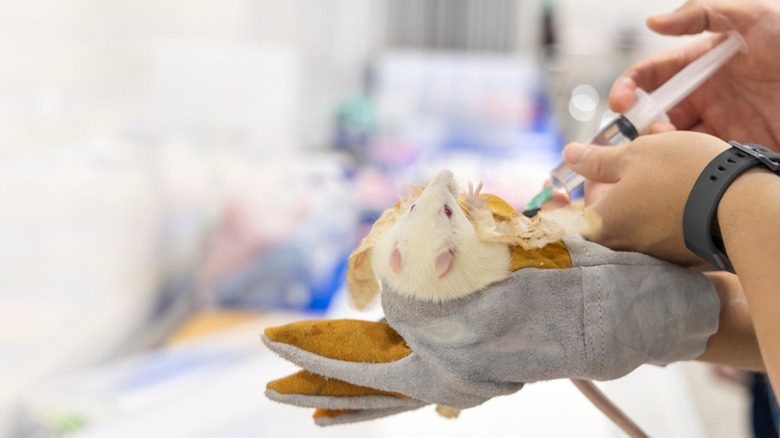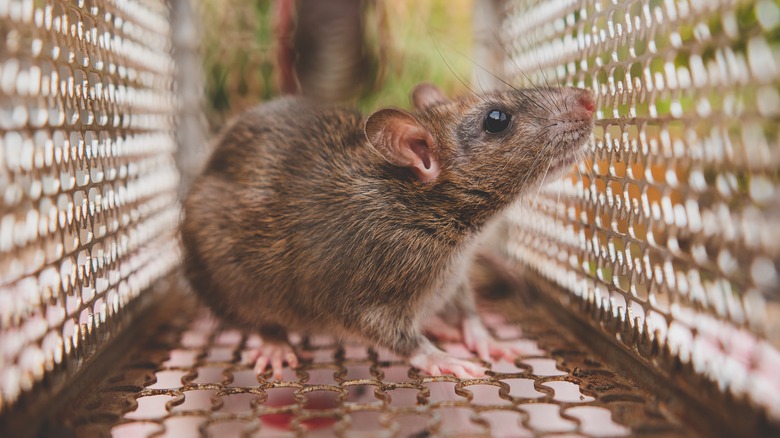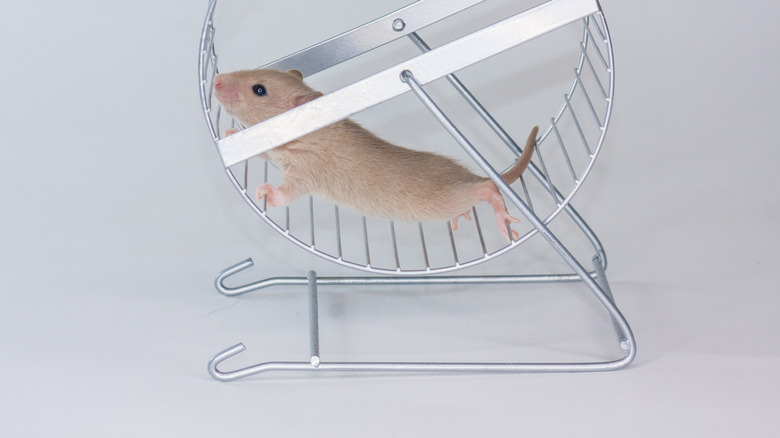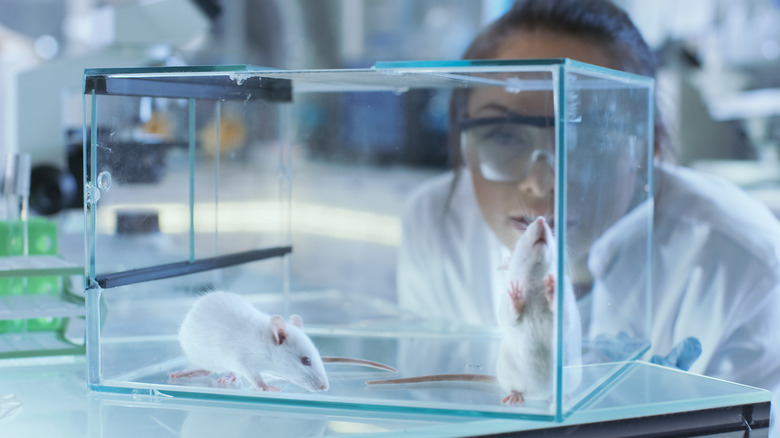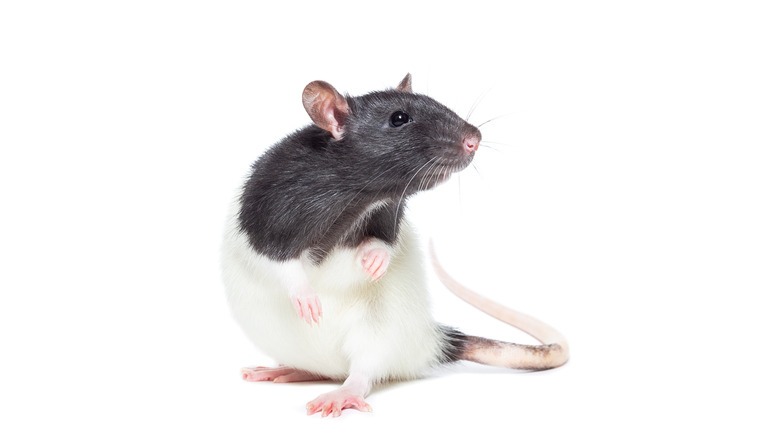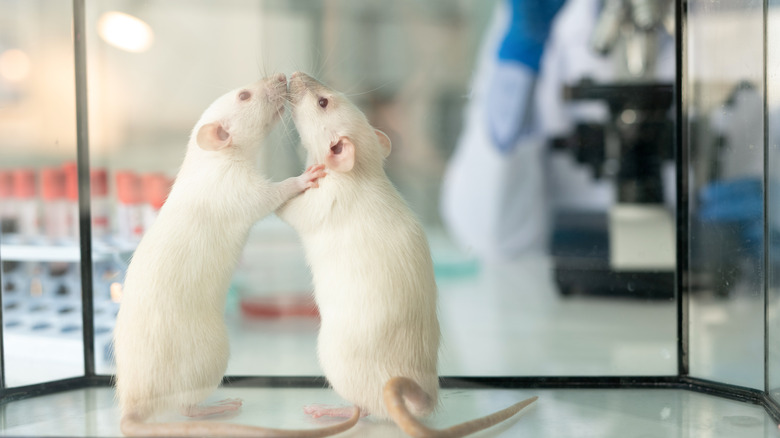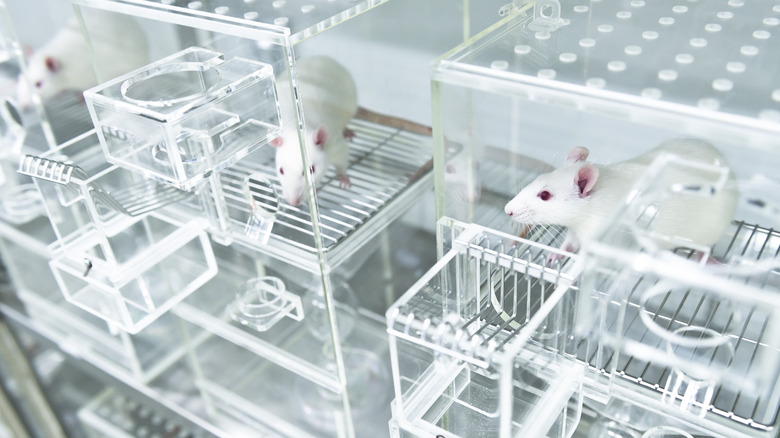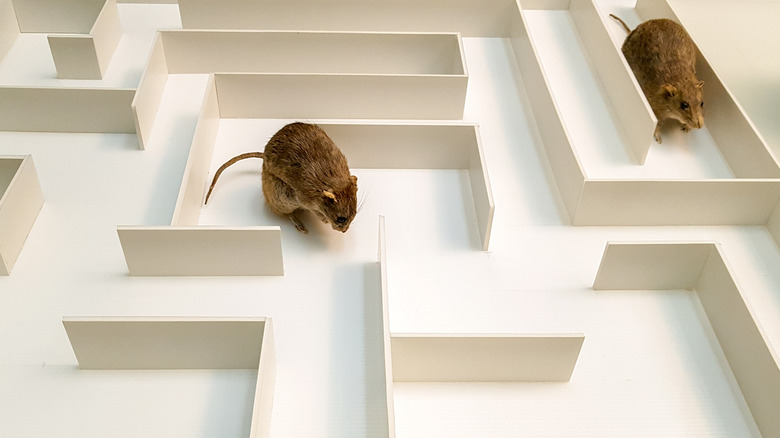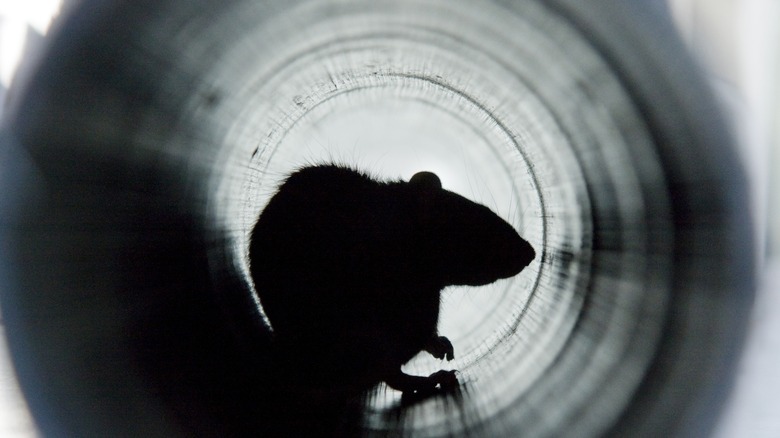How Rats Changed Science Forever
Ah, rats! The strange little intruders of our apartments and kitchens. Not quite as cute as a mouse, but not quite as intimidating as a raccoon systematically sifting through the neighbors rubbish. What most can agree on is that in most settings, they perturb us beyond control. But is it really them, or is it our lack of appreciation? Because one thing is for certain about rats — and it's not about the bubonic plague before you interrupt — they have undoubtedly made modern medicine what it is today. Maybe not the one living between the drywall of your pantry right now, but it's a safe bet that their relatives probably have had a respectable career in a lab somewhere.
People have been using rats and plenty of other animals for hundreds of years to understand their own bodies, per the International Journal of Preventative Medicine. But it wasn't until scientific research really picked up steam in the 19th century that people started to agree that "comparative medicine" was necessary for the advancement of medical science. Since 1966, close to half a million studies have used rats, according to Genome Research. Here's why lab-coat aficionados love to use this humble yet mighty rodent in particular, and how it changed science forever.
Rats Pioneered Scientific Discovery
According to "The Laboratory Rat: Biology and Diseases, Volume 1," rats were the pioneers of comparative medicine — meaning, they were the first animal models to be bred for research. As far as what's recorded, scientists started using them as models in the mid-19th century. The first experiment on record is from 1856, which studied the after-effects of removing the rodent's adrenal glands. Another study published in The Lancet 1863 used rats to observe how the various levels of nitrogen in food impact nutrition and health.
But it wasn't until the in 20th century when things really started to take off for rat models. After the biomedical researcher Henry H. Donaldson published "The Rat: Reference Tables and Data for the Albino Rat and the Norway Rat," his institution began selling albino rats, aka, Wistar Rats, by the batches. He also discovered that rat nervous systems were not only quite similar to man's in design but also in the rate in which they develop.
The first huge strides of these particular research breeds were found during early experiments with vitamins. One scientist wrote, "These rats and their growth curves were basic factors in nutrition research, and without them, this research would have been delayed ... and that delay would have been serious for the feeding of starving nations from 1915 to 1919."
They Have Helped Us Understand Our Own Genes
If you've been going through life set on the idea that you and a rat have nothing in common, you're about to be downright dumbfounded. You, and the rest of us silly homo sapiens, share about 95% of our DNA with rats, per Missouri Medicine. In 2004, the rat was the third animal to have a complete genome mapped right behind the mouse and humans, per Nature.
This milestone has been nothing short of tremendous, as it's given scientists a much clearer understanding of what our own genes do, how humans evolved, every single biological factor related to human health, and plenty of other things that dictate our identity pretty much, per National Human Genome Research Institute. The genetic mapping project also highlighted the amazing discovery that nearly every human disease has a genetic copy in rats.
Changing Rats' Genomes Allows for Way More Research
Rat genes have been so thoroughly researched, scientists have quickly discovered ways in which to alter them to hone in on studies. Manipulating genes in an animal model means there are ways to understand certain treatments that scientists would never be able to if it was tested on humans. And, it also really helps that it's easy to make specific breeds for just as specific of studies.
Where does man-handling rats' genes manifest into better science one might quibble? Well, kind of in everything. As an example, one study on gut and joint inflammatory disease (via Rockefeller University Press) used rats with an engineered gene that impacts the adaptivity of the immune system. Findings highlighted that gut health is directly related to arthritis, and that the bacteria in the intestines play a big role in how the disease develops.
And if tailoring a rat's genes as easily as if they were an actual pair of jeans wasn't already mind blowing enough, scientists can make them glow. But why? Well, the lab coats started adding a fluorescent green protein to rat genomes so their cells would be easily detected under a microscope. This makes it especially faster when running high-stakes experiments on things like transplanted organs and immunity, per Missouri Medicine.
They Are Ideal For Practicing Specialized Surgeries
While it might come as a surprise on account of their petite physique, rats are pretty ideal for testing a number of medical procedures. Mice are usually the first choice when it comes to biomedical study because they're genetically more similar to humans, but because rats are 10 times their size, they tend to make for better subjects for surgery, according to Kent Scientific. Interestingly, rats are also more receptive to human touch and can actually be trained to stay still during some procedures.
Increasingly, rats have been prime candidates for brain and spinal surgeries. In 2017, scientists were able to make a rat with a severed spinal cord walk again with a breakthrough surgery using human stem cells, per Reuters. The cells were taken from a person's mouth and eventually placed in the rat's spine where the brain could talk to the cells and get to work on repairs. This feat is pretty mind blowing, given that spinal cord injuries are incredibly difficult to recover from since those nerves can't regenerate on their own.
Another groundbreaking study tested a new, chemical-free method of moving cancer cells away from a brain tumor. It was one of the first methods of its kind where cells move towards the treatment drug, rather than the drug going to treat the cells. The success of the model in rats shows the potential for an entirely new approach to treating malignant brain tumors in the future.
They Provide Huge Insights into Understanding Disease
If there's one massive contribution that rats have made to scientific research, it's disease with a capital D. The University of Cambridge reports that rats have played a foundational role in the world of medicine, from cardiovascular conditions to neural regeneration. Before the 20th century, scientists were just scratching the surface of understanding how the human body, and any other body for that matter, really functioned, according to Disease Control Priorities in Developing Countries. In fact, it wasn't until after World War II that the study of disease really began to take modern shape. Before then, if you had diabetes or came down with cancer, the assumption was that you were just getting old.
Today, with the complete mapping of the genome sequence in every scientist's back pocket, researchers are now able to manipulate rat genes in order to study just about any disease on the lab table, per Ingenious Targeting Laboratory. Because of rats, scientists understand what genes contribute to our susceptibility to certain illnesses, and the rodents have helped us identify 350 genes related to disease, according to the Journal of Biomedical Science.
One of those genes is associated with the rare condition Phelan-McDermid syndrome, a disease that impacts neurological development. Scientists can now observe it and test treatments on rat models. By identifying this gene, researchers hope to find effective therapies for people who have been struggling with this condition without any treatment thus far.
They Have Been Big Heroes in Cardiovascular Study
When it comes to the most deadly diseases worldwide, the heart takes the cake, per the CDC. More than 135 million deaths occur from cardiac arrest each year, according to the American Heart Association. Consequently, cardiovascular research is always in high demand, and rats are usually the top choice for this area of study, a main reason being that their genes are easy to alter for heart disease.
Scientists have created certain breeds that naturally develop cardiovascular diseases, as well as exhibit genes that make them susceptible to such diseases, according to Frontiers in Cardiovascular Medicine. This has given researchers a wealth of insight into how these conditions behave in the human body and have allowed them to develop life saving treatments related to heart failure both on the surgical side, as well as the drug side.
Rats play such a foundational role in studying heart conditions that there are 19 specialized breeds for this area of biomedical research. Some breeds are given genes where they're born with predispositions to high blood pressure, insulin resistance, and poor athleticism — all of which provide researchers with prime models to dial in the research that much more. Rats even help with treatments related to post-cardiac arrest symptoms, like improving brain function by giving a patient temporary hypothermia, per Resuscitation. Turns out, hypothermia is super helpful for brain recovery after a heart attack in a lot of cases.
Rats Made Strides for Diabetic Research
Diabetes is a top contender for major health conditions in the United States, and rats tend to do a great job with modeling the numerous factors involved with diabetes, especially when it comes to external factors that are so common with diabetes like stress, diet, and toxins, per Neural Regeneration Research.
In 2017, Stanford Medicine successfully grew a mouse's pancreas inside of a rat (with insulin producing cells), which was then transplanted to diabetic mice. Totally successful organ transplants are still pretty new in the world of medicine, and on top of that, the blood glucose of these mice reached normal levels within a year of the transplant. The study suggests that this method could eventually be used on larger animals to grow human pancreases that would in turn reverse diabetes.
In 2022, scientists found an ideal candidate for Type 2 diabetes research in the Nile rat from Africa, according to UC Santa Barbara. What makes this rat so wonderfully suited for progressing treatments for Type 2 diabetes? Simply put, its diet makes it super easy to develop the disease, and it enjoys being up during the day. Both of these attributes are pretty weird for rats but a huge advantage in diabetic research that has struggled to find suitable models in the past.
They Are Rockstars in Leading the Age of Stem Cells
Rats have been helping make huge gains when it comes to stem cell research — some that include the potential for life-saving surgery, and others for new ears. In 2020 at the University of Pittsburgh, rats were successfully given tiny human livers grown from human skin cells. The results had huge implications to the potential studies around stem-cell-produced organs and changing the landscape of organ transplants in the future. It also provided some insight for potential liver treatments rather than a full transplant.
A similar study from the National Institutes of Health in 2013 speaks to how awesome rats are for the future of readily available organs like lab-grown kidneys. The kidneys in question were sprouted from engineered cells, and while they didn't work as well as a rat's own-grown kidney, they did work. And since kidney failure tends to have a pretty significant impact on peoples' quality of life, future endeavors in growing kidneys that function could very well be in the cards.
In 1997, researchers from were able to affectively grow "tissue engineered cartilage" on a rat (via Plastic and Reconstructive Surgery). The findings added yet another stepping stone into refining stem cell techniques geared towards reconstructive surgery. Thanks to that study, scientists today don't have to grow ears on the backs of rats anymore, they can just do it in vitro, per eBioMedicine.
They Play a Foundational Role in Development of Pharmaceuticals
Since 1938, the Food and Drug Administration has required animal testing for the safety and efficacy of pharmaceutical drugs. In the past few decades, rats have played a foundational role in helping develop drugs as commonplace as anesthesia, per NLM. Feats like these mean that rats and other animal models have played a pivotal role in laying the foundation for modern medicine and surgery. Nowadays, rats help test the effectiveness of drugs ranging from chemotherapies to anti-anxiety medication, so it's a good chance that whatever you have in your medicine cabinet right now had a rat involved.
Until December 2022, the Food and Drug Administration required animal testing for pharmaceutical drugs before clinical trials on willing human participants. While the new law doesn't require animal testing anymore, it also doesn't say that researchers can't continue using animals. The scientific community will most likely continue using rats, along with plenty of other animals, for the time being until better comparative models come out as the technology gets better, according to Science.
Rats are Literally Driving Neurological Research
If you think that you don't think like a rat ... you'd be half right. Maybe they can't make you a ham sandwich, but they can drive cars, per the University of Richmond. They also have a slew of neurological similarities to humans when it comes to psychology, neurological diseases, and neurotransmitters (for fun things like serotonin), per Disease Models & Mechanisms. They even show addictive and impulsive behaviors like us, which makes them fairly good models for a variety of brain studies.
A foundational aspect of neurological research has been understanding the evolution of the human brain, and because the study of genetics is such a necessary part of that process, rats tend to save the day in that area where comparison models are essential. While it may seem unbelievable, rats have extremely similar neural networks in comparison to humans, reports NPR.
In 2022, Stanford Medicine researchers put human brain cells into rat noggins to study brain development and neurological diseases like Timothy syndrome, which often causes epilepsy and seizures in young people (via Nature). There is no current treatment to directly target this condition, and studying rats that exhibit the condition allows scientists to get a better understanding of how to prevent or treat rarities like this in the future.
They Help us Understand our Own Psyche
Rat behavioral psychology has been studied since 1892, starting at Clark University in Worcester Massachusetts, according to "The Laboratory Rat: Biology and Diseases." One of the first studies involved how alcohol, among other things, impacted a rat's activity. Adolf Meyer, who was considered one of the most influential psychiatric researchers of the 20th century, started breeding specific albino rats for psychological studies, per Integrative Physiological and Behavioral Science.
Early on, rats were found to be stupendous models for psychological research on account of their many similarities to humans. Through this, rats have helped us understand our own psychological quirks like the Bystander Effect (via Science Advances), or how population density combined with comfortable living can negativity impact socialization (via Scientific American). Among plenty of other fascinating experiments on the table — but this one is probably the most enduring — scientists have given rats DMT to study the association of how micro-dosing psychedelics helps with depression and PTSD, per ACS Chemical Neuroscience.
Rats Help Us Better Understand Mental Illness
Because rats are so helpful in the realms of neurological and psychological research, they're unsurprisingly just as helpful when it comes to understanding and finding treatments for mental health conditions. To start, rats and humans have a very naughty vice in common when it comes to impulsivity, according to the British Journal of Pharmacology. This comes in handy when studying treatments for alcohol disorders or impulse control problems at large. And with other mental health problems on the rise like anxiety, rats are extremely helpful in showing how medications can impact other aspects of the self, like empathy, per Frontiers. The outcomes of these studies help to improve on existing drugs made for anxiety disorders.
Another study on heroin and meth from the National Institute on Drug Abuse showed a new way to approach addiction research due to the influence of social motivation. In short, rats actually want to hang out with each other more than do super hard drugs. This shows that socialization has a pretty powerful impact on neurological response, which expands the scientific community's previous notions around the relationship between drugs and well being.
